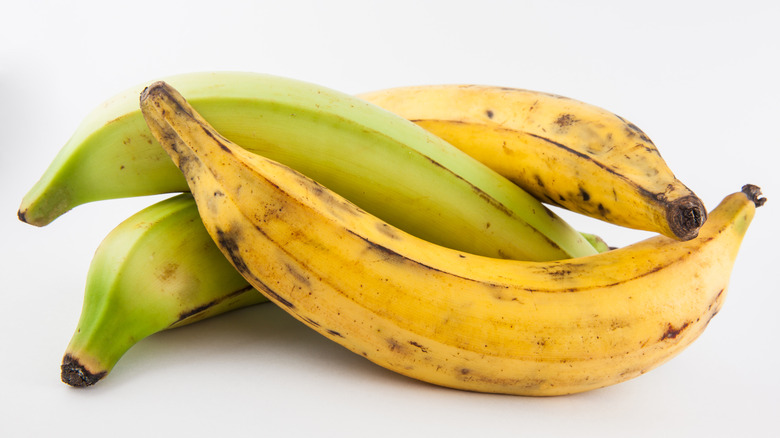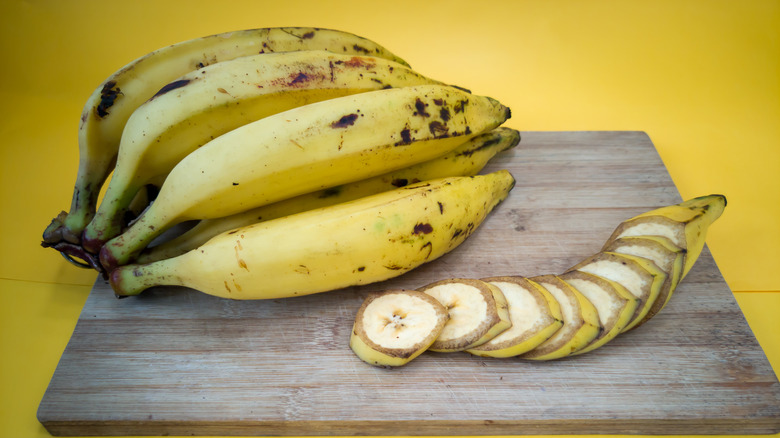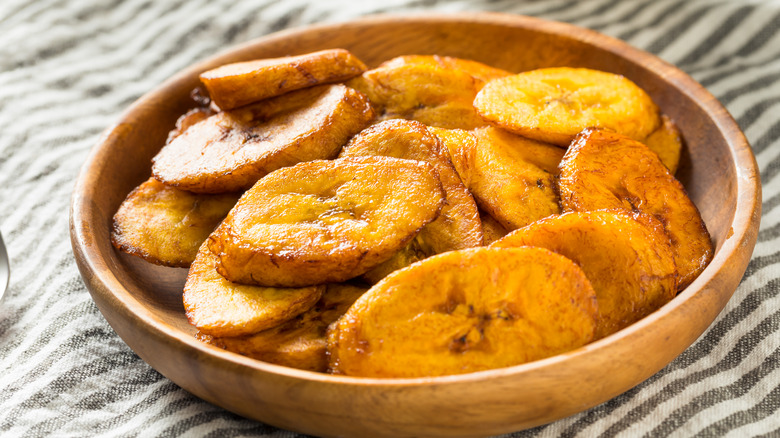What To Look For When Buying Unripe Plantains
Many cultures around the world cook with plantains to make all kinds of sweet or savory dishes, from easy snacks to complex meals. Plantains are easy not to waste since they can be cooked at nearly every stage of ripeness. Due to their high starch content, they're often treated like potatoes, having the versatility to be fried, boiled, mashed, or baked.
If you're just now starting with plantains in the kitchen, it's important to know when the fruit is ready for the recipe you're after. While plantains can be cooked at any stage of ripeness, you need to know what ripeness is best for the specific dishes you're making. For instance, unripe plantains are perfect to slice and fry until golden or make Puerto Rico's savory mofongo, whereas ripe ones are perfect for whipping up a sweet dessert.
With many tasty plantain recipes out there, it may seem overwhelming to incorporate this fibrous fruit into your diet. And when it comes to recipes that use green unripe plantains, it all starts with picking out the right batch. How exactly do you go about buying and incorporating them into your meals at home?
Unripe plantains are more firm and less sweet than ripe
There are many obvious signs that demonstrate whether a plantain is ripe or not, and most indications can be spotted pretty obviously, even by an untrained eye.
The first signal that a plantain is ripe or not is by looking at the color. Just like bananas, unripe plantains display green skin. Slowly, they will get more yellow and eventually bear mostly brown spots at peak ripeness. However, the dark brown will eventually take over, leading to a spoiled plantain.
When it comes to texture and feel, unripe plantains will be firmer to the touch. Ripe plantains, on the other hand, will still exhibit firmness when touched but will also have a little give and maybe even be slightly soft. The fruit in its unripe form will be too solid to mash up easily. However, this firm texture is an advantage when being fried as the fruit will hold its shape easier as opposed to a ripened plantain.
Another easy way to tell a plantain's ripeness level is the flavor. If you bite into an unripe raw plantain, you'll most likely be met with the absence of sweetness. Unripe plantains have a savory flavor, whereas ripe plantains will be sweeter and fuller in flavor.
How to cook with unripe plantains
If you're looking to make a very simple snack of fried plantains or plantain chips, starting with unripe plantains is ideal. When their skin is green and they're firmer, it's easier to slice them up since they maintain their form after the cooking process. This type of plantain dish is enjoyed all over the world, from West Africa to Central America, where they are sometimes called "tajadas" and can be eaten either sweet or savory.
If you're craving a hearty breakfast, Cayeye, or Cabeza de Gato, from Colombia, is a tasty dish with scrambled eggs, onion, avocado, cheese, and mashed green plantain. This country also features boiled green plantains in a light soup simply called sopa de plátano. A more filling dinner with this unripe fruit may be best served the Puerto Rican and Dominican way — pasteles. This tamale-adjacent dish has a wrap made of both grated unripe plantains and plantain leaves, and it is filled with meat, often pork.


